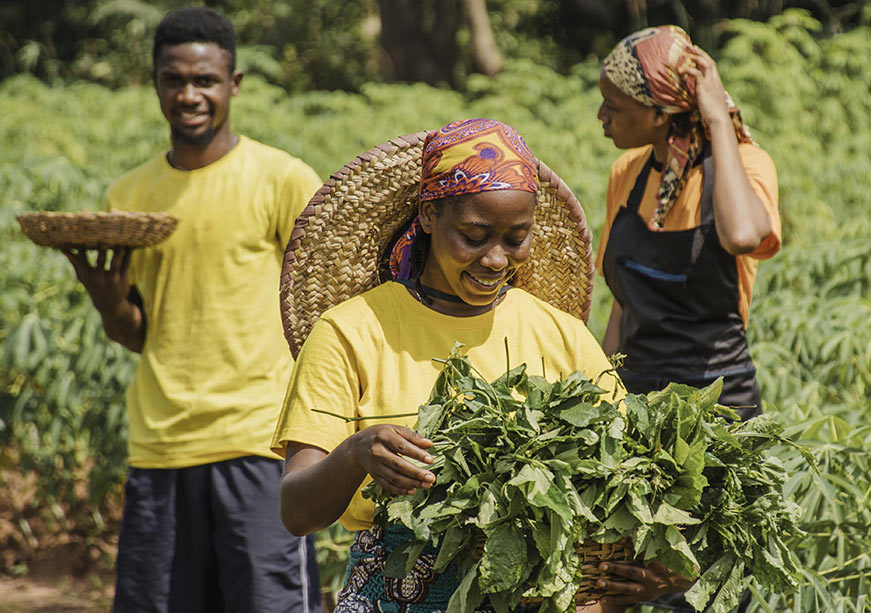As Africa urbanises amid a warming climate, climate-smart food systems offer a path to resilience, sustainability, and shared prosperity.
Introduction
Africa is undergoing unprecedented urbanisation and rapidly accelerating climate change, which is also affecting food systems. By 2050, the continent’s urban population is expected to double, reaching 1.4 billion. Concurrently, climate change, among other factors, has been reducing agricultural productivity and worsening food and nutritional security across the continent. These twin crises of climate and urbanisation demand an integrated solution to unsustainable urbanising trends and escalating environmental pressures on food systems. Climate-smart food security systems (CSFS) offer a pathway to navigate these challenges, synergistically bolstering urban resilience, enhancing agricultural productivity, and protecting the environment.
The Twin Challenges: Rapid Urban Growth and Climate Vulnerability
Urbanisation in Africa is primarily driven by rural-urban migration, conflict, displacement, and natural population growth. Around 60 -70 percent of urban growth in countries such as Uganda and Ethiopia comes from births exceeding deaths. Rapid city expansion often converts agricultural land, forests, wetlands, and other natural areas into built environments. Poor governance and weak land-use planning exacerbate food insecurity by displacing peri-urban farms and disrupting local ecosystems. This shift worsens biodiversity loss, urban heat islands, and flood risks, leaving urban food systems more vulnerable to shocks. At the landscape/cityscape level, the loss of vegetation cover disrupts the ecological balance, contributing to a decline in biodiversity, worsening urban heat island effects, and altering local precipitation patterns. The increase in impervious surfaces, from new roads and buildings, is leading to more surface runoff, which contributes to frequent and severe flooding. This dynamic reveals a paradox: the very growth to drive economic development can simultaneously make a city’s food system more vulnerable to shocks by increasing its dependence on less resilient supply chains. The urban poor are disproportionately affected, as they rely on localised food systems and informal markets that are less resilient to disruptions. This highlights the need to explicitly integrate food provisioning into the planning of African cities to avoid the emergence of new vulnerabilities in the pursuit of growth.
Climate-Smart Solutions: Building Resilient Food Systems
Climate change causes erratic rainfall patterns, droughts, floods, and higher temperatures, which have already reduced agricultural productivity. Rainfed agriculture productivity has declined by 34 percent since 1961 due to climate change. Without adaptation, rainfed yields could drop by 50 percent by 2050 in some countries. These environmental stresses increase food prices, reduce incomes, and threaten the livelihoods of millions of farmers, herders, and fisherfolk. Climate shocks act as a “threat multiplier,” worsening poverty, health crises, and social unrest. An assessment of global food security confirmed these are worldwide challenges. However, Africa is uniquely vulnerable due to its high dependence on rainfed agriculture, limited adaptive capacity, and pre-existing socio-economic challenges.
CSFS practices deliver “triple wins”: higher productivity and incomes, adaptation and greater climate resilience, and mitigation or lower greenhouse gas emissions. This suite of practices is key to ensuring food and income security for a rapidly growing population. The most successful interventions often bundle multiple benefits, creating a compounding positive effect that goes far beyond a single objective. CSFS interventions include:
- Climate-resilient breeds and crop varieties, such as drought-tolerant types, help growers in adapting to water scarcity. Agroecological methods such as intercropping, composting, and biological pest control enhance soil fertility and biodiversity while reducing chemical use.
- Basic Tech innovations: Solar irrigation pumps, digital solutions, such as mobile-based weather forecasts, and affordable storage systems help smallholders reduce losses and improve yields.
- Urban and Vertical Agriculture – Rooftop and vertical gardens in cities like Nairobi and Accra localise food production, reduce supply chain vulnerabilities, and provide ecosystem services such as storm water management, cooling, and air purification.
- Agroforestry and Conservation Agriculture: Combining trees with crops and livestock enhances soil health, water retention, and carbon sequestration. For instance, the Kilimanjaro “Kihamba” system and Kenya’s Tana watershed project, which have restored landscapes and boosted farmer incomes. The Mezimbite Forest Centre of central Mozambique restores miombo woodland while securing food and income. Conservation agriculture practices such as minimal soil disturbance and crop rotation reduce labour needs and improve drought resilience. Agroforestry is not merely about planting trees; it’s a multi-faceted approach that contributes to carbon storage, water management, biodiversity, and diverse income streams. Conservation agriculture, relying on the principles of minimum soil disturbance, permanent soil cover, and crop rotation, is gaining ground across the continent. In Ghana, Zambia, and Tanzania, these practices improve soil moisture retention and promote resilience, particularly in drought-prone areas. By reducing the need for heavy machinery and labour-intensive tillage, conservation agriculture makes smallholder farmers more efficient and profitable. These solutions effectively address multiple challenges simultaneously, creating compounding benefits greater than the sum of their parts. Investments in CSFS offer a superior return, generating positive outcomes across environmental, social, and economic dimensions.
- Mitigation Strategies: This includes interventions that reduce emissions and promote carbon sequestration through reforestation, rangeland management, better soil and water management, methane emissions reduction from livestock via improved feeding practices, clean energy use, and circular economy approaches like converting food waste into compost or bioenergy, which reduces environmental footprint.
The holistic nature of these interventions means they address a bundle of challenges, from food access to energy efficiency, with effective solutions.
Weaving the Fabric of Change: Financing and Institutional Support
Scaling up requires supportive policy and robust multi-stakeholder partnerships. Blended finance, climate funds, and green bonds can cover high upfront costs. Microfinance and mobile banking help farmers access credit for equipment and ideal seeds. Land tenure reforms incentivise long-term investments, while gender-sensitive policies ensure women can access resources and training. Institutions play a pivotal role in sustaining progress. The rubric of the Comprehensive Africa Agriculture Development Programme (CAADP) recently reaffirmed commitments to climate-smart food security. Each of the African Union (AU) member states implements CAADP through a National Food Security Investment Plan. This includes multiple implementation strategies, such as the AU’s Climate Change and Resilient Development Strategy and the Africa Climate Smart Agriculture Implementation Plan (CSAIP). A gap remains between ambition and implementation. For example, 60 percent of African countries have a CSAIP strategy, but only 25 percent have financed and implemented investment plans. This poses a significant hurdle given the high initial costs of adopting smart practices, whereas smallholder farmers have limited access to credit. Insecure land tenure discourages long-term investments in land-improving practices. Moreover, women often face limited access to resources and information, impacting their ability to adopt higher-return practices. The author has also emphasised the urgency of integrating gender and nutrition considerations into the design of development programmes. The clear disconnect between high-level policy and on-the-ground reality prompts a reconciliation of political will and institutional capacity. The priority is not addressing policy, but removing the structural barriers that prevent its implementation.
The good news is that multi-stakeholder collaboration is catalysing change. The World Economic Forum’s Food Innovation Hubs serve as an example, bringing together governments, researchers, private sector companies, and farmer organisations to drive scalable, localised solutions. Private sector initiatives are also playing a crucial role, for example, OCP (Office Chérifien des Phosphates now OCPNutriCrops), a leading plant nutrition company, runs a “School Lab” that provides free soil analysis and fertiliser recommendations to nearly a million smallholder farmers across 10 countries.27 These partnerships, which pool resources and expertise, are essential for tackling the complex, interconnected nature of Africa’s food security challenges.
Conclusion: Crisis to Opportunity
Africa’s urbanisation and climate change crises are deeply interconnected. Resolving these issues demands a holistic approach that links urban planning, sustainable agriculture, and climate action. Evidence suggests these forces interconnect, forming complex environmental, social, and economic challenges. By investing in CSFS, Africa can build a more resilient, productive, and prosperous future. The path forward requires a shift from fragmented, single-sector interventions to a holistic, integrated approach. This involves integrating urban planning with agricultural policy, promoting sustainable practices such as agroforestry and conservation agriculture, and making a concerted effort to reduce the substantial amount of food loss and waste that affects the food system. Most critically, it requires addressing the systemic barriers that limit progress, including insecure land tenure and limited access to finance and information, particularly for women and youth. The solutions are not in a single policy or technology, but in the collaboration of diverse stakeholders, including policymakers, private companies, local farmers, and urban communities. By adopting climate-resilient genetics, agroecological practices, urban farming, and circular economy approaches, Africa can develop resilient food systems that enhance livelihoods while minimising environmental impacts. Financing innovations and strong institutions will be essential for scaling these efforts. The continent’s future food security depends on transforming cities from vulnerable consumer centres into hubs of sustainable production. By investing in CSFS today, Africa can build a greener, more equitable future where urban and rural communities thrive together. African cities must not just be concrete and steel, but earthy, infinitely more powerful. An earthy foundation of the soil beneath our feet, enabling the resplendence of plants, waters, landscape features, and creatures that abound across the continent.
Moffatt Ngugi is an ecologist specialising in climate, agriculture, and natural resource management, focused on advancing food security through sustainable innovation.












